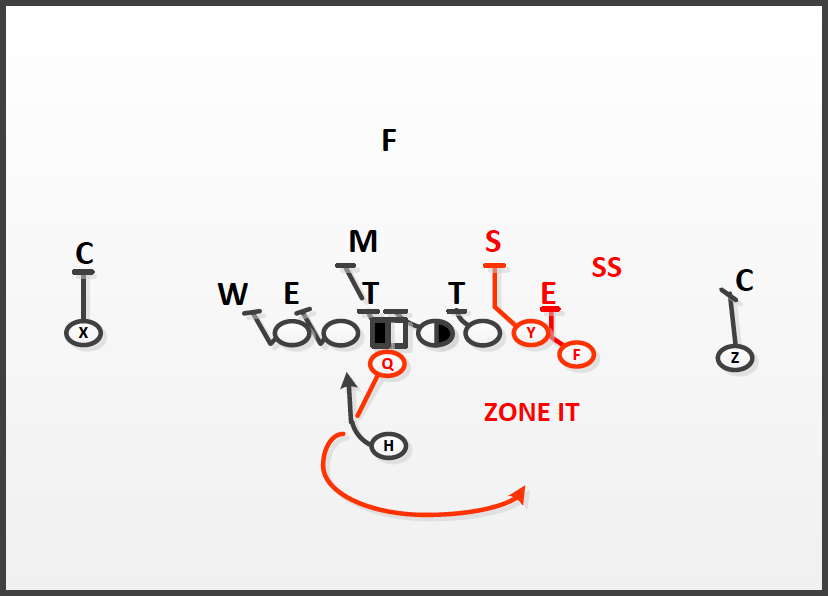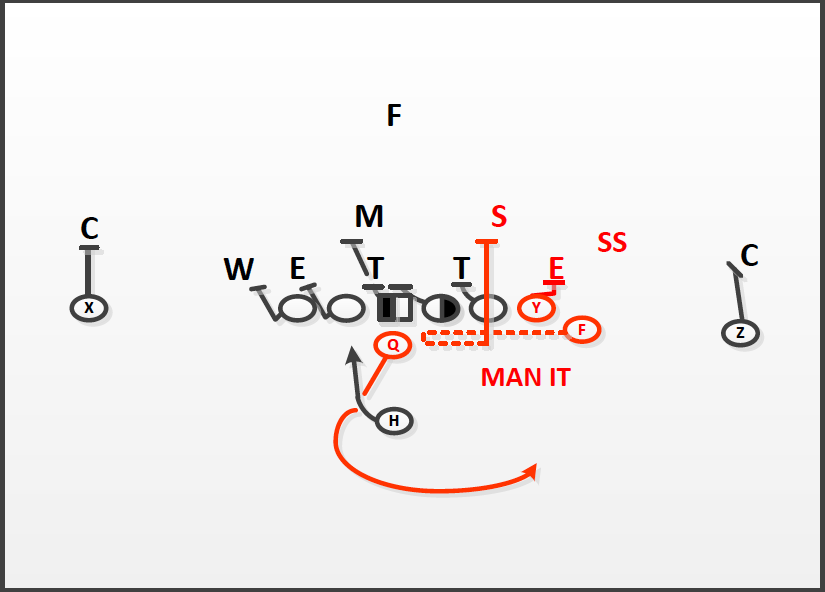Backside Inside Zone Blocking
Quarterbacks are responsible for the backside on inside zone blocking these days. The popularity of the zone read and the RPO has made the backside inside zone blocking harder to find. In our opinion you still need it though. There are times when you do not want your quarterback reading an RPO or even the defensive end. You want the ball handed off to get the two yards for a first down. This is when you need to give your tight ends and tackles the tools to be successful.
Anyone who has taught or coached the inside zone knows that there is no play side or backside to it. The weak side zone play or Blunt as it is commonly referred can hit anywhere. If you charted this play, the ball hits back over the tight ends’ side more than it hits to the open side.
The play we are looking at today is run from a 3×1 set with two tight ends. It starts weak to get the defense running. Then the ball carrier normally cuts back and the ball hits directly over the original alignment of the center. The defense reacts to the initial footwork of the back and the defensive front fights to maintain their gap control. When this happens the critical blocks often fall on the two tight ends cutting off the backside.
Tight End Zone Scheme On The Backside Of 3×1 Inside Zone Blocking
When blocking an over defense the center, guard and tackle are working to block the shade, 3 technique and Mike linebacker. The tight ends are left to zone block the defensive end and Sam linebacker. The tight ends have some disadvantages.
Size and often times leverage are two things that the tight ends must take into account. They are blocking a defensive end who is bigger and a Sam linebacker who is normally a great athlete. Well coached defensive linemen will also do a great job to get their hands on the blockers. Getting to the second level defender can be hard vs this technique. Ends will also penetrate upfield, making the zone block almost impossible because the two tight ends are starting on different levels.
Thousands & Thousands of Run Game Drawings (That You Can Edit)
If the inside zone play is run enough times in a game, eventually the SLB is going to start fast flowing. This makes hard for the Y to give enough help to the F on the zone block and get off on the SLB. The advantages that the tight ends have is that one of them is off of the line of scrimmage. He can move in motion to gain leverage.
This gives your F a chance to do several things. He can keep the defense on their toes up until the last split second before the ball is snapped. The defense does not know if he is going across the formation or not. The wing can also stop at multiple spots when he begins to return to his original alignment. He can stop inside of the Y. He can also motion back to the wing position or he can even motion back outside to an extended alignment. This is why it is important for the wing to motion with a sense of urgency.
Tight End Man Scheme On The Backside Of 3×1 Inside Zone Blocking
As the video shows the man blocking scheme can also be executed without motion. The Y needs to aggressive on the defensive end so that here is no penetration. The F will need to cheat back a little with his alignment. This will give him a chance to fit up on the SLB. The F must also account for the flow of the SLB if he is to have a chance on this block. It is still essential that both players run their feet and finish their blocks.
You will notice that the quarterback and strong safety are also in red on the drawings. Regardless of what run play you call you will always be one player short if the defense plays eight defenders in the box. The QB can help offset this by giving the defense a hard naked fake after the handoff. This will make the safety hesitate just enough to give the ball carrier a chance to get north south on the run before the safety can get involved. Even if your QB is not a run threat he can hold the safety with the threat of a two on one naked pass to one of the tight ends or the X on an over route.



